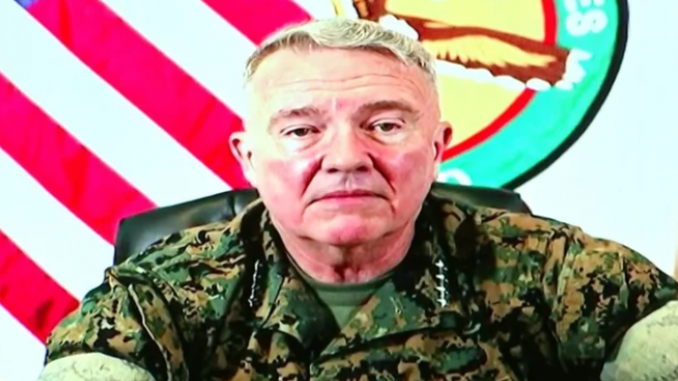
The Pentagon on Friday confirmed it mistook a civilian vehicle for an ISIS-K threat when it launched a drone strike on Aug. 29 in Kabul that killed 10 civilians.
“I am now convinced that as many as 10 civilians, including up to seven children, were tragically killed in that strike,” U.S. Central Command head Gen. Frank McKenzie told reporters at the Pentagon. “Moreover, we analyzed that it is unlikely that the vehicle and those who died were associated with ISIS-K or were a direct threat to U.S. forces.”
“Our investigation now concludes that the strike was a tragic mistake,” he said.
McKenzie also offered his “profound condolences to the family and friends of those who were killed.”
“This strike was taken in the earnest belief that it would prevent an imminent threat to our forces and the evacuees at the airport, but it was a mistake and I offer my sincere apology. As the combatant commander, I am fully responsible for the strike and this tragic outcome,” he said.
Pentagon officials had previously asserted that at least one ISIS-K member and three civilians were killed when the U.S. military struck a vehicle it said was “an imminent ISIS-K threat” to U.S. forces evacuating people at Kabul’s airport.
Shortly thereafter, reports emerged that the U.S. military targeted the driver of the vehicle, Zemari Ahmadi, based on dubious claims, including because they believed he may have had ties to ISIS and that explosives had been put in his vehicle.
But the driver did not have ties to the terrorist organization and instead was a worker at an aid group, Nutrition and Education International, the investigation found.
Centcom had also pointed to “significant secondary explosions” once the mistaken target was struck as evidence the vehicle was carrying a “substantial amount of explosive material.”
But McKenzie said the most likely cause of the accompanying blasts was “the ignition of gas from a propane tank located immediately behind the car. Such an ignition would have created a brief but massive fireball.”
In trying to explain the mistake, McKenzie said that in the 36 hours leading up to the strike the U.S. military had at least 60 different intelligence reports — some “corroborating and some conflicting” — about a threat to U.S. forces at Kabul’s airport.
“One of the most recurring aspects of the intelligence was that ISIS-K would utilize a white Toyota Corolla as a key element in the next attack,” he said.
“We didn’t take the strike because we thought we were wrong, we took the strike because we thought we thought we had a good target,” McKenzie said.
But when asked by a reporter to explain how the “complete and utter failure” happened, McKenzie said it “certainly was a terrible mistake and we certainly regret that,” but “would not qualify the entire operation” as a failure.
“While I agree with it this strike certainly did not come up to our standards and I profoundly regret it, I would not qualify the entire operation in those terms,” he said.
McKnezie would not say if anyone would be held responsible, as the Pentagon is in the process of investigating that possibility.
He added that the Pentagon is “exploring the possibility of ex gratia payments” to surviving family members of those killed.
Following McKenzie’s comments, Defense Secretary Lloyd Austin offered his own condolences “to surviving family members of those who were killed, including Mr. Ahmadi, and to the staff of Nutrition and Education International, Mr. Ahmadi’s employer.”
Austin, who said McKenzie briefed him on the investigation’s findings earlier Friday, said the Defense Department now knows “there was no connection between Mr. Ahmadi and ISIS-Khorasan, that his activities on that day were completely harmless and not at all related to the imminent threat we believed we faced, and that Mr. Ahmadi was just as innocent a victim as were the others tragically killed.”
“We apologize, and we will endeavor to learn from this horrible mistake,” Austin said in a statement.
The Pentagon chief also said he had directed a review of the Centcom investigation to see whether it considered all available context and information, “the degree to which accountability measures need be taken and at what level, and the degree to which strike authorities, procedures and processes need to be altered in the future.”
“We will scrutinize not only what we decided to do — and not do — on the 29th of August, but also how we investigated those outcomes,” Austin said. “We owe that to the victims and their loved ones, to the American people and to ourselves.”
Joint Chiefs of Staff Chairman Gen. Mark Milley also released his own statement calling the strike a “heart wrenching” and “horrible tragedy.”
“In a dynamic high-threat environment, the commanders on the ground had appropriate authority and had reasonable certainty that the target was valid, but after deeper post-strike analysis, our conclusion is that innocent civilians were killed,” Milley said in a statement.
“This is a horrible tragedy of war and it’s heart wrenching and we are committed to being fully transparent about this incident,” he added.
After the Pentagon’s public apology, human rights groups released their own statements condemning the mistake.
The American Civil Liberties Union said the strike “should be an inflection point and wake-up call at long last” to the consequences of carrying out attacks that harm civilians.
“If President Biden truly means to center human rights, he needs to end the lethal force-first approach of the last 20 years, and also end this country’s program of lethal strikes even outside recognized battlefields,” the ACLU said in a statement. “For too long, U.S. presidents have flouted the rights-protecting safeguards of international law and our system of checks and balances, with devastating consequences for human lives.”
And Amnesty International said that while the Pentagon’s statements are an “important step toward accountability” more steps need to be taken.
Via The Hill
